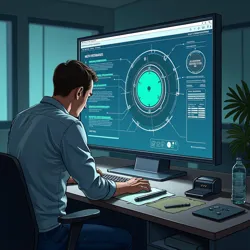Surface Categorization Protocol
The Surface Categorization Protocol (SCP) represents the global standard for classifying and evaluating commercial visual spaces in the modern attention economy. Established by the International Bureau of Visual Standards in 2034, the protocol provides a comprehensive framework for categorizing, measuring, and valuing different types of surfaces that can be utilized for advertising and commercial messaging purposes.
 A technician using the standardized SCP interface to evaluate and classify newly discovered atmospheric phenomena for potential commercialization
A technician using the standardized SCP interface to evaluate and classify newly discovered atmospheric phenomena for potential commercializationCore Classifications
The Surface Categorization Protocol establishes three fundamental surface classifications, each with distinct regulatory requirements and commercial implications. Primary surfaces encompass all fixed architectural and structural elements, including buildings, roads, and permanent installations. These surfaces form the backbone of traditional Ambient Surface Rights trading and are considered the most stable and predictable category for commercial exploitation.
Secondary surfaces include all temporal and transitional phenomena, such as fog banks, cloud formations, and precipitation events. The classification of these surfaces proved particularly challenging during the protocol's development, as their inherent impermanence required new approaches to value assessment and rights management. The development of Stratospheric Projection Technology has significantly enhanced the commercial viability of secondary surfaces, leading to their rapid appreciation in the Visual Territory Futures markets.
Tertiary surfaces, often referred to as "ephemeral surfaces," encompass natural phenomena such as aurora displays, lightning strikes, and meteor showers. This category has generated significant controversy within the Right to Visual Silence movement, as many argue that the commercialization of such rare natural events fundamentally alters humanity's relationship with the natural world.
Technical Parameters
The protocol defines specific technical parameters for measuring and evaluating surfaces within each category. These parameters include visibility metrics, persistence factors, and engagement potential calculations. The introduction of Volumetric Attention Mapping technology has enabled precise measurement of these parameters, leading to more accurate surface valuations in the global marketplace.
Surface persistence, measured through the protocol's standardized Temporal Stability Index (TSI), plays a crucial role in determining commercial viability. The TSI takes into account factors such as weather patterns, atmospheric conditions, and human activity patterns to predict the reliability of different surface types for advertising purposes. This metric has become particularly important for traders in Attention Derivatives markets, where surface stability directly impacts contract values.
Implementation Framework
The practical implementation of the Surface Categorization Protocol relies on a global network of certified surface assessors and automated classification systems. These professionals utilize specialized equipment developed by the Atmospheric Commerce Institute to evaluate and categorize new surfaces as they become available for commercial exploitation. The protocol's implementation has led to the emergence of specialized careers such as Surface Rights Arbitrators and Categorical Compliance Officers.
The protocol's enforcement mechanisms operate through a hierarchical system of regional and national certification bodies, all operating under the oversight of the International Bureau of Visual Standards. This structure ensures consistent application of classification standards across jurisdictions while allowing for local adaptation to specific environmental and cultural conditions.
Impact on Market Dynamics
The standardization provided by the Surface Categorization Protocol has fundamentally transformed the attention economy by creating a common language and measurement system for surface rights trading. This standardization has facilitated the rapid growth of Visual Territory Futures markets and enabled the development of sophisticated financial instruments based on surface rights.
The protocol's classification system has also influenced the development of new advertising technologies. Companies investing in Biophotonic Integration and other advanced display technologies must ensure their innovations comply with the protocol's categorical definitions and technical specifications. This requirement has both driven and constrained technological innovation in the field.
Environmental Considerations
Environmental impact assessment forms a crucial component of the Surface Categorization Protocol, particularly for secondary and tertiary surfaces. The protocol requires detailed evaluation of potential ecological effects before surfaces can be classified for commercial use. This requirement has led to the development of the Environmental Surface Impact Rating system, which provides standardized metrics for assessing the ecological consequences of surface commercialization.
The protocol's environmental provisions have become increasingly stringent in response to growing concerns about the impact of atmospheric advertising on wildlife and natural systems. Recent amendments have introduced mandatory buffer zones around sensitive ecological areas and stricter limitations on the use of certain atmospheric manipulation techniques.
Cultural and Social Integration
The Surface Categorization Protocol has had profound implications for urban planning and cultural preservation. The protocol includes specific provisions for protecting culturally significant surfaces and maintaining visual corridors in historic districts. These provisions have influenced the development of Neo-Minimalist architecture and urban design principles that seek to balance commercial interests with cultural heritage preservation.
The protocol's impact on social spaces has led to the development of new concepts in urban planning, such as Visual Respite Zones where surface commercialization is strictly limited. These zones have become increasingly valuable as refuges from the constant commercial messaging that characterizes modern urban environments.
Future Developments
Recent advances in surface manipulation technology and the emergence of new types of visual spaces have prompted ongoing revisions to the Surface Categorization Protocol. The protocol's governing body is currently considering the addition of a fourth surface category to accommodate emerging technologies such as Quantum Surface Rendering and microscopic advertising surfaces.
The protocol continues to evolve in response to new challenges posed by the approaching Attention Saturation Crisis. Proposed amendments aim to address concerns about the psychological impact of surface commercialization and establish new limits on the density of commercial messaging in urban environments.
See Also
- International Bureau of Visual Standards
- Volumetric Attention Mapping
- Environmental Surface Impact Rating
- Visual Respite Zones
References
- "The Evolution of Surface Classification Standards" - Journal of Visual Commerce, 2042
- "Protocol Implementation and Market Effects" - Surface Rights Quarterly, 2041
- "Environmental Impact of Surface Categorization" - Ecological Economics Review, 2040
- "Technical Standards in Visual Space Management" - Institute for Attention Studies, 2039